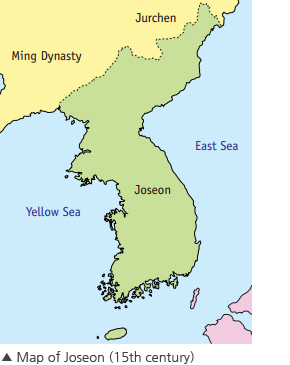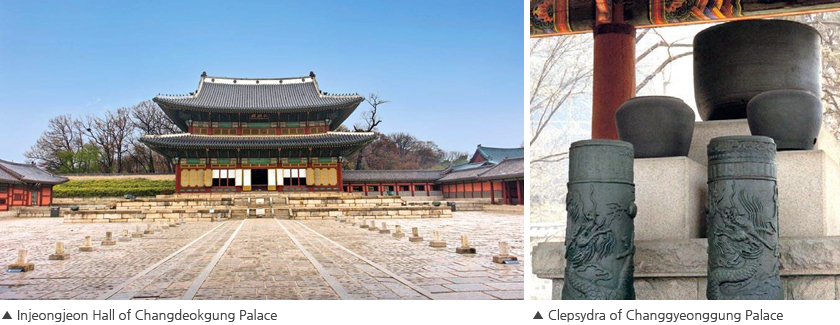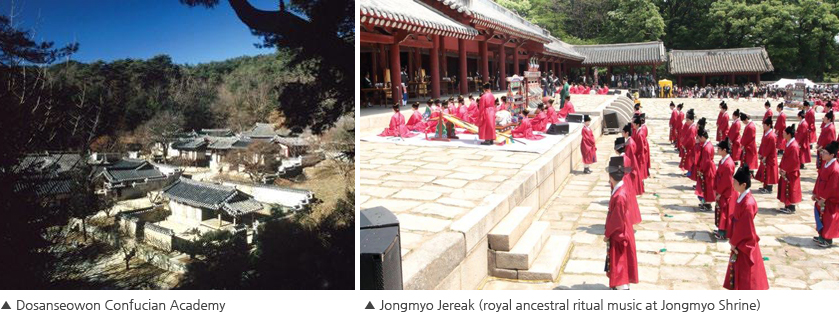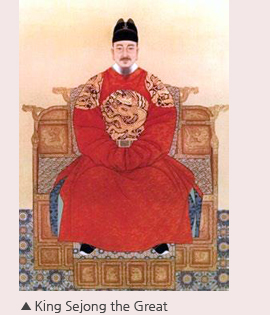Culture Focus
Korea in the World
History before 1945: Joseon Dynasty
 |
Joseon DynastyThe literati class emerged as a new force toward the end of the Goryeo Dynasty. Established through an alliance between the new literati class and military officers, the Joseon Dynasty came to power by dynastic revolution in 1392 and ruled the peninsula for more than 500 years.The founders of Joseon adopted Neo-Confucianism as its ruling philosophy. It replaced Buddhism as the leading socio-political ideology, bringing great changes in thought, family structure, governance, artistic styles and literature, and social behaviors that still inform present-day Korean culture. |
During the Joseon Dynasty, the social status of the general populace improved. The early Joseon period was an era of transition from a hereditary aristocratic society to a yangban-centered bureaucratic society. The scholarly officials of the yangban class (two strata of literary and military elites) were selected through state examinations.
It was a period when national borders expanded in size, and the nation’s ethos developed and matured. It was also during this period that the Korean alphabet, Hangeul, was invented by King Sejong (r. 1418–1450). King Sejong promoted science and supported the development of great scientific inventions such as the sundial and clepsydra (water clock). The first two hundred years of the Joseon Dynasty saw significant philosophical, socio-political, and artistic developments.
It was a period when national borders expanded in size, and the nation’s ethos developed and matured. It was also during this period that the Korean alphabet, Hangeul, was invented by King Sejong (r. 1418–1450). King Sejong promoted science and supported the development of great scientific inventions such as the sundial and clepsydra (water clock). The first two hundred years of the Joseon Dynasty saw significant philosophical, socio-political, and artistic developments.

Under the dominance of Confucian teachings, studying Chinese and Korean classics was very important. Institutions of higher learning in Korea were established from the fourth century. During the Joseon period, various levels of schools emerged: elementary schools (seodang), government-run local schools (hyanggyo), private Confucian academies (seowon), and the National Confucian Academy (Seonggyungwan) in the capital.
Respect for one’s elders, along with other Confucian teachings on human relations, was emphasized. Schools had shrines to express reverence for great scholars and teachers, while respect for one’s ancestors was the most important part of education. Family rituals served as the main occasion for consolidating the unity of the clan and educating the younger generation.
The ultimate ritual of filial piety in the Confucian system took place for the royal family at Jongmyo Shrine, the royal ancestral shrine. Korea is no longer a monarchy, but the Jeonju Yi [Lee] Royal Family Association, which descended from the Joseon Dynasty, conducts ancestral rituals at Jongmyo Shrine in accordance with ancient, official protocols.
Respect for one’s elders, along with other Confucian teachings on human relations, was emphasized. Schools had shrines to express reverence for great scholars and teachers, while respect for one’s ancestors was the most important part of education. Family rituals served as the main occasion for consolidating the unity of the clan and educating the younger generation.
The ultimate ritual of filial piety in the Confucian system took place for the royal family at Jongmyo Shrine, the royal ancestral shrine. Korea is no longer a monarchy, but the Jeonju Yi [Lee] Royal Family Association, which descended from the Joseon Dynasty, conducts ancestral rituals at Jongmyo Shrine in accordance with ancient, official protocols.

| Hangeul: the Korean Script | |
 |
Perhaps Korea is the only country on earth to have a writing system intentionally created by the king for the people (1443). Called Hangeul, the Korean script is a precious piece of heritage and a source of national pride for Koreans. The Korean language is different from Chinese. It belongs to completely different language family—closer to Japanese, but as different from Chinese as it is from English. Thus, Chinese characters were difficult and inconvenient for common Koreans’ daily use. The innovative writing system of Hangeul, which represents the sounds of the Korean language, would eventually replace the more complicated Chinese characters and make it easier for ordinary Koreans to learn to read and write. This is why King Sejong, the inventor of the writing system, called it Hunminjeongeum, meaning “proper sounds for educating people.” |
| Scholarly elites of the yangban class, who preferred classical Chinese, at first looked down upon this easy-to-learn writing system. However, Hangeul was used widely in many official documents such as property transaction contracts and family property distribution, as well as in personal diaries and letters between families. |
|
Korea in the World
It is not easy to understand a foreign country in a short time. is a brief introduction of Korea for educators unfamiliar to Korea. The booklet collects and summarizes significant historical, cultural, and politico-economical traces of Korea. An essential material for educators who want to bring Korea in the textbook and to classroom.
It is not easy to understand a foreign country in a short time.

